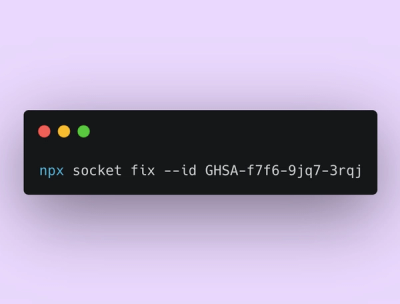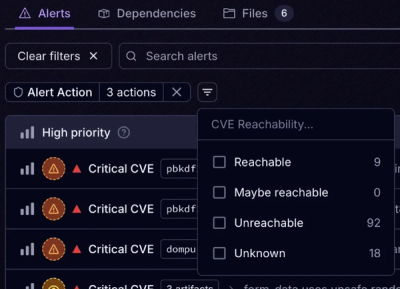
Product
Announcing Socket Fix 2.0
Socket Fix 2.0 brings targeted CVE remediation, smarter upgrade planning, and broader ecosystem support to help developers get to zero alerts.
Pytorch Modules for XGBoost and LightGBM
XGBoost and LightGBM are industry-standard gradient boosting packages used to solve tabular data machine learning problems. Users of these packages wishing to define custom loss functions, novel architectures, or other advanced modeling scenarios, however, may face substantial difficulty due to potentially complex gradient and Hessian calculations required by both XGBoost and LightGBM. GBNet provides PyTorch Modules wrapping XGBoost and LightGBM so that users can construct and fit nearly arbitrary model architectures involving XGBoost or LightGBM without requiring users to provide gradient and Hessian calculations. PyTorch's autograd system calculates derivative information automatically; GBNet orchestrates delivery of that information back to the boosting algorithms. GBNet, by linking XGBoost and LightGBM to PyTorch, expands the set of applications for gradient boosting models.
There are two main components of gbnet:
(1) gbnet.xgbmodule, gbnet.lgbmodule and gbnet.gblinear provide the Pytorch Modules that allow fitting of XGBoost, LightGBM and Boosted Linear models using Pytorch's computational network and differentiation capabilities.
F(X)$ is the output of an XGBoost model, you can use Pytorch to define the loss function, $L(y, F(X))$. Pytorch handles the gradients of $L$ so, as a user, you only specify the loss function.\sigma(F(user) \times G(item))$ where both $F$ and $G$ are separate boosting models producing embeddings of users and items respectively. gbnet makes defining and fitting such a model almost as easy as using Pytorch itself.(2) gbnet.models provides specific example estimators that accomplish things that were not previously possible using only XGBoost or LightGBM. Current models:
Forecast is a forecasting model similar in execution to Metas' Prophet algorithm. In the settings we tested, gbnet.models.forecasting.Forecast beats the performance of Meta's Prophet algorithm (see the forecasting PR for a comparison).GBOrd is Ordinal Regression using GBMs (both XGBoost and LightGBM supported). The complex loss function (with fitable parameters) is specified in PyTorch and put on top of either XGBModule or LGBModule.pip install gbnet
Use of virtual environments/conda is best practice when installing GBNet. GBNet requires XGBoost, LightGBM and PyTorch as key dependencies and may use these packages simultaneously. Each of these packages rely on OpenMP implementations for parallelization. Conflicts in the OpenMP implementations will throw warnings and may produce slow or incorrect outputs. Prior to installing these python dependencies, it is best to ensure each of these dependencies point to a single OpenMP implementation. Apple Silicon users may prefer to install libomp via brew prior to the python package dependency installations (see, for example, build notes for XGBoost for additional details).
There are currently three Pytorch Modules in gbnet: lgbmodule.LGBModule, xgbmodule.XGBModule and gblinear.GBLinear. These create the interface between PyTorch and the boosting algorithms. LightGBM and XGBoost are wrapped in LGBModule and XGBModule respectively. GBLinear is a linear layer that is trained with boosting (rather than gradient descent) -- for some applications it trains much faster than gradient descent (see this PR for details).
Gradient Boosting Machines only require gradients and, for modern packages, hessians to train. Pytorch (and other neural network packages) calculates gradients and hessians. GBMs can therefore be fit as the first layer in neural networks using Pytorch.
CatBoost is also supported but in an experimental capacity since the current gbnet integration with CatBoost is not as performant as the other GBDT packages.
gbnet model closer to training a neural network or to training a GBM?It's closer to training a GBM. Currently, the biggest difference between training using gbnet vs basic torch, is that gbnet, like basic usage of xgboost and lightgbm, requires the entire dataset to be fed in. Cached predictions allow these packages to train quickly, and caching cannot happen if input batches change with each training/boosting round. There are some ways around this but there is currently no native functionality in gbnet for true batch training. Additional info is provided in #12.
import time
import lightgbm as lgb
import numpy as np
import xgboost as xgb
import torch
from gbnet import lgbmodule, xgbmodule
# Generate Dataset
np.random.seed(100)
n = 1000
input_dim = 20
output_dim = 1
X = np.random.random([n, input_dim])
B = np.random.random([input_dim, output_dim])
Y = X.dot(B) + np.random.random([n, output_dim])
iters = 100
t0 = time.time()
# XGBoost training for comparison
xbst = xgb.train(
params={'objective': 'reg:squarederror', 'base_score': 0.0},
dtrain=xgb.DMatrix(X, label=Y),
num_boost_round=iters
)
t1 = time.time()
# LightGBM training for comparison
lbst = lgb.train(
params={'verbose':-1},
train_set=lgb.Dataset(X, label=Y.flatten(), init_score=[0 for i in range(n)]),
num_boost_round=iters
)
t2 = time.time()
# XGBModule training
xnet = xgbmodule.XGBModule(n, input_dim, output_dim, params={})
xmse = torch.nn.MSELoss()
X_dmatrix = xgb.DMatrix(X)
for i in range(iters):
xnet.zero_grad()
xpred = xnet(X_dmatrix)
loss = 1/2 * xmse(xpred, torch.Tensor(Y)) # xgboost uses 1/2 (Y - P)^2
loss.backward(create_graph=True)
xnet.gb_step()
xnet.eval() # like any torch module, use eval mode for predictions
t3 = time.time()
# LGBModule training
lnet = lgbmodule.LGBModule(n, input_dim, output_dim, params={})
lmse = torch.nn.MSELoss()
X_dataset = lgb.Dataset(X)
for i in range(iters):
lnet.zero_grad()
lpred = lnet(X_dataset)
loss = lmse(lpred, torch.Tensor(Y))
loss.backward(create_graph=True)
lnet.gb_step()
lnet.eval() # use eval mode for predictions
t4 = time.time()
print(np.max(np.abs(xbst.predict(xgb.DMatrix(X)) - xnet(X_dmatrix).detach().numpy().flatten()))) # 9.537e-07
print(np.max(np.abs(lbst.predict(X) - lnet(X).detach().numpy().flatten()))) # 2.479e-07
print(f'xgboost time: {t1 - t0}') # 0.089
print(f'lightgbm time: {t2 - t1}') # 0.084
print(f'xgbmodule time: {t3 - t2}') # 0.166
print(f'lgbmodule time: {t4 - t3}') # 0.123
import time
import numpy as np
import torch
from gbnet import lgbmodule, xgbmodule
# Create new module that jointly trains multi-output xgboost and lightgbm models
# the outputs of these gbm models is then combined by a linear layer
class GBPlus(torch.nn.Module):
def __init__(self, input_dim, intermediate_dim, output_dim):
super(GBPlus, self).__init__()
self.xgb = xgbmodule.XGBModule(n, input_dim, intermediate_dim, {'eta': 0.1})
self.lgb = lgbmodule.LGBModule(n, input_dim, intermediate_dim, {'eta': 0.1})
self.linear = torch.nn.Linear(intermediate_dim, output_dim)
def forward(self, input_array):
xpreds = self.xgb(input_array)
lpreds = self.lgb(input_array)
preds = self.linear(xpreds + lpreds)
return preds
def gb_step(self):
self.xgb.gb_step()
self.lgb.gb_step()
# Generate Dataset
np.random.seed(100)
n = 1000
input_dim = 10
output_dim = 1
X = np.random.random([n, input_dim])
B = np.random.random([input_dim, output_dim])
Y = X.dot(B) + np.random.random([n, output_dim])
intermediate_dim = 10
gbp = GBPlus(input_dim, intermediate_dim, output_dim)
mse = torch.nn.MSELoss()
optimizer = torch.optim.Adam(gbp.parameters(), lr=0.005)
t0 = time.time()
losses = []
for i in range(100):
optimizer.zero_grad()
preds = gbp(X)
loss = mse(preds, torch.Tensor(Y))
loss.backward(create_graph=True) # create_graph=True required for any gbnet
losses.append(loss.detach().numpy().copy())
gbp.gb_step() # required to update the gbms
optimizer.step()
t1 = time.time()
print(t1 - t0) # 5.821
gbnet.models.forecasting.Forecast outperforms Meta's popular Prophet algorithm on basic benchmarks (see the forecasting PR for a comparison). Starter comparison code:
import pandas as pd
from prophet import Prophet
from sklearn.metrics import root_mean_squared_error
from gbnet.models import forecasting
## Load and split data
url = "https://raw.githubusercontent.com/facebook/prophet/main/examples/example_yosemite_temps.csv"
df = pd.read_csv(url)
df['ds'] = pd.to_datetime(df['ds'])
train = df[df['ds'] < df['ds'].median()].reset_index(drop=True).copy()
test = df[df['ds'] >= df['ds'].median()].reset_index(drop=True).copy()
## train and predict comparing out-of-the-box gbnet & prophet
# gbnet
gbnet_forecast_model = forecasting.Forecast()
gbnet_forecast_model.fit(train, train['y'])
test['gbnet_pred'] = gbnet_forecast_model.predict(test)['yhat']
# prophet
prophet_model = Prophet()
prophet_model.fit(train)
test['prophet_pred'] = prophet_model.predict(test)['yhat']
sel = test['y'].notnull()
print(f"gbnet rmse: {root_mean_squared_error(test[sel]['y'], test[sel]['gbnet_pred'])}")
print(f"prophet rmse: {root_mean_squared_error(test[sel]['y'], test[sel]['prophet_pred'])}")
# gbnet rmse: 8.757314439339462
# prophet rmse: 20.10509806878121
See this notebook for examples.
from gbnet.models import ordinal_regression
sklearn_estimator = ordinal_regression.GBOrd(num_classes=10)
Contributions are welcome! Here are some ways you can help:
Before submitting a pull request:
pytestFor major changes, please open an issue first to discuss what you would like to change.
Horrell, M., (2025). GBNet: Gradient Boosting packages integrated into PyTorch. Journal of Open Source Software, 10(111), 8047, https://doi.org/10.21105/joss.08047
FAQs
Gradient boosting libraries integrated with pytorch
We found that gbnet demonstrated a healthy version release cadence and project activity because the last version was released less than a year ago. It has 1 open source maintainer collaborating on the project.
Did you know?

Socket for GitHub automatically highlights issues in each pull request and monitors the health of all your open source dependencies. Discover the contents of your packages and block harmful activity before you install or update your dependencies.

Product
Socket Fix 2.0 brings targeted CVE remediation, smarter upgrade planning, and broader ecosystem support to help developers get to zero alerts.

Security News
Socket CEO Feross Aboukhadijeh joins Risky Business Weekly to unpack recent npm phishing attacks, their limited impact, and the risks if attackers get smarter.

Product
Socket’s new Tier 1 Reachability filters out up to 80% of irrelevant CVEs, so security teams can focus on the vulnerabilities that matter.